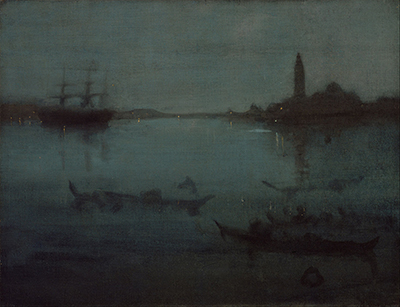When Vincent Van Gogh noted that 'If you truly love nature, you will find beauty everywhere' he seemed to be addressing the UK based American artist James Abbott McNeil Whistler.
His love for painting was derived more from real life rather than illusions and seemed to see beauty in almost everything. The choice of colors too were symbolic and in his painting of the Nocturne in Blue and Silver: The Lagoon, Venice, the color blue represents calmness though, in mythology, it was associated with the gods. The painter wanted to show the humility the night holds in a thousand words with the simplest of paintings from scene painting instead of memory.
Nocturne initially applied to musical compositions inspired Whistler to embrace the night evocation to his works of art like the Nocturne in Blue and Silver. The painting's mysterious beauty in line color and composition explores the mood and atmosphere in a flattened pictorial space with the reduced Venice in blue and silver ghostly representing the city’s structure. With a mimic of the big city with the silhouette of San Giorgio Maggiore church and distant lights along the horizon, Whistler painted Venice as poet Lord Byron had described in his poem, Fairy City of the Heart.
Although other painters took shots at painting this view, Whistler deviated from the approach and painted its night version with the use of mist and darkness to make it have a magnificent look. Using oil in his work, he thinned it with copal and turpentine which he applied in thin and transparent layers. The washing down paint made the church's bulky dome dreamlike. Apart from the Nocturne in Blue and Silver, Whistler's other Nocturnes include Nocturne: Blue and Silver - Chelsea, Nocturne: Blue and Silver-Cremorne Lights, Nocturne, Grey and Gold and the Nocturne: Blue and Gold-Southampton Water.
The painter, in all his Nocturnes aimed at perfectly conveying night themes with their natural beauty and tranquility. Fredrick Leyland who was the first to suggest the night themed paintings added musical associations though Whistler redirected into the artistic bit alone. Whistler admitted to having been strongly inspired to accomplish this and his other Nocturne works by the Japanese art of ukiyo-e; pictures of the floating world. Some of James Abbott McNeill Whistler's paintings have been hung in his studio archives, while others are randomly distributed in museums for exhibition.




